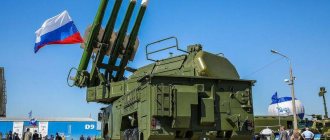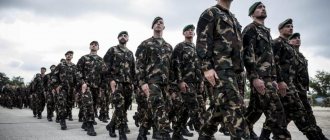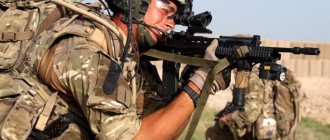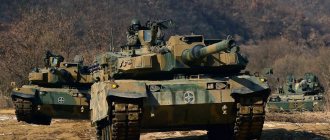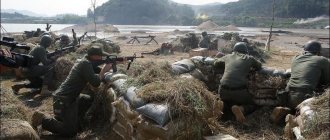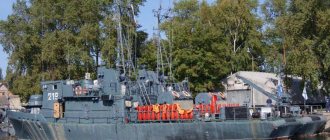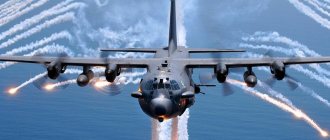Creation of the Republic of Korea Armed Forces
The South Korean army began to be created immediately after the Second World War. The first combat units were national defense units. These small units primarily performed police functions and were created under the control of the American occupation forces. Accordingly, the training of personnel was carried out by US Army instructors.
Shortly after gaining statehood, on November 30, 1948, the law “On the Creation of a National Army” was issued, which for many years determined the principles of military development in the country. In 1949, the Republic of Korea began receiving US weapons on a regular basis.
Links[edit]
- . December 2022.
- Choi, Dalhi; Kim, Dongjin (1949). (in Korean). YouTube. Retrieved September 8, 2016.
- Choi, Dal-hee; Kim, Dong Jin (1949). (in Korean). YouTube. Retrieved September 8, 2016.
- Choi, Dal-hee; Kim, Dong Jin (1949). (in Korean). YouTube. Retrieved September 8, 2016.
- Choi, Dal-hee; Kim, Dong Jin (1949). . Retrieved March 21, 2017.
- Choi, Dal-hee; Kim, Dong Jin (1949). (in Korean). YouTube. Retrieved March 19, 2022. The 용진 The WC The 용지 방패
- Klingner, Bruce. . Heritage Foundation
. - Pike, John. . www.globalsecurity.org
.
Baptism of fire for the South Korean army
The first combat operation in which the young army of South Korea had to participate occurred in the summer of 1948 during the communist uprising on Jeju Island. The rebels demanded fair democratic elections and the reunification of South and North Korea.
The number of rebel troops was about 4,000 people. Initially, the rebels managed to achieve serious military successes. But in the spring of 1949, after four reinforced battalions of the South Korean army were transferred to the island, the initiative passed to the side of the official government. Most of the rebel troops were defeated. The population of the island who supported the communists was subjected to repression. Since that time, the South Korean army has also been assigned a police role in the state.
Notes
- It is not clear when the fight took place. According to some data posted on the “SOUTH KOREAN ARMY” page, the ship was sunk several hours before the North Korean invasion by ship N-703, according to others (James A. Field, Jr. “History of United States Naval Operations: Korea”) the battle happened in the evening. And according to the description on the Commander website, US Naval Forces Korea, everything happened on the night of June 27, when the patrol ship Paektusan in the Korea Strait near Busan collided with an unidentified vessel weighing 800 tons. The ship was attacked and responded with fire. In the next battle, Paektusan sank another ship carrying North Korean troops that were supposed to capture Busan. Moreover, the unknown ship of 800 tons that was attacked was the Soviet cable ship Plastun.
- According to the Australian War Memorial website, 13 aircraft were lost.
List of monarchs of Korea
Korean War
In June 1950, hostilities began between the DPRK and South Korea, which went down in history as the Korean War. This war had a decisive impact on the South Korean army, its strength and development strategy for decades. This war was also the bloodiest since the Second World War. Koreans died on both sides.
By the beginning of the war, the strength of the South Korean army was just under one hundred thousand people. The bulk of the military units were light infantry units. There were practically no armored vehicles. The number of artillery was insignificant. The small South Korean fleet consisted mainly of patrol boats (about 10 units), minesweepers (35 units) and auxiliary vessels (20 units).
The Army of the Republic of Korea experienced great difficulties with its command personnel. By the beginning of the war, the number of officers, especially in the lower echelons of military command, did not meet the needs of the army. The recently opened military school did not have time to provide the army with command personnel by the beginning of the war. The shortage of personnel became even greater after the start of active hostilities. The insufficient number of its officers was covered by attracting instructors from the US Army. By the beginning of hostilities, the number of American advisers was about 500 people.
All these circumstances had a negative impact on the actions of South Korean units during the initial period of the war. The weakly armed infantry divisions of the South Korean army were unable to provide significant resistance to the DPRK forces and actually gave the entire territory of the country to the North Koreans, with the exception of a small bridgehead in the south of the peninsula. And only the intervention of the US Army and its allies made it possible to change the situation in the theater of operations.
The war led to heavy losses in the army. In total, the South Korean armed forces lost about 140 thousand people killed. To replenish the army, the leadership of the Republic of Korea had to call up about 500 thousand more military personnel. Since that time, the South Korean army has remained virtually unchanged in size.
After the war with the DPRK, the Republic of Korea continued to actively build its armed forces. The improvement of the army took place with the direct support of the American administration, since the country's economy at that time was still weak to bear high military expenses.
Controversy
Violation of the Forced Labor Convention
The Forced Labor Convention explicitly excludes "any work or service required by virtue of the laws of compulsory military service and applied to work of a purely military character" from its scope.
However, the ILO defines military service for non-military purposes as forced labour. According to the ILO, conscription into the Korean army violates the forced labor convention because Korea recruits men with disabilities for non-military purposes. The majority (+90%) of "Reserve - Class 4 -" work as "Social Service Agent (사회 복무 요원)" and work at wages well below the legal minimum wage in various fields including government agencies, subway stations, taxes. offices, post offices and a sanatorium. In April 2022, Korea ratified the Forced Labor Convention. But Korea's call has not changed. Korea changed its conscription law to grant "the right to make enlistment decisions" to "Reserve Class 4—persons with minor disabilities." Korea argues that the change makes conscription legal because "4th Class Reserves" now have the right to choose conscription methods between active-duty soldiers and "social service agents."
However, the ILO has reported that forcing a "reserve class 4-" to work as a "social service agent" is a violation of the Forced Labor Convention in a number of their annual reports.
Vietnamese Mission of South Korea
The next combat episode in the history of the South Korean army was the Vietnam War.
During the initial period of the Vietnam War, the Army of the Republic of Korea allocated a small contingent of 10 training officers and a military hospital with a staff of 130 people to be sent to the combat zone. But a year later, the size of the group was radically increased to 50 thousand people. The following were transferred from the South Korean army to Vietnam:
- two infantry divisions;
- Marine Brigade;
- transport air group;
- squad of warships.
Taking into account the turnover of personnel, the number of troops who went through the war amounted to more than 300 thousand South Korean military personnel.
The Army of the Republic of Korea lost about 5 thousand people in this war. The number of wounded exceeded 11 thousand. Since the Korean War, South Korea's participation in hostilities in Vietnam was the largest in terms of the number of casualties and the number of troops involved.
In fact, these victims became payment for US economic assistance. During the fighting in Indochina, the Republic of Korea received about $5 billion in aid from Washington. Of this, the government spent 1 billion on military needs, namely, on providing an army force in Vietnam.
CONTENT
- 1 Institution
- 2 Requirements 2.1 Enrollment and physical examination
- 2.2 Types and duration of services
- 2.3 Exceptions 2.3.1 Sports
- 2.3.2 Music and art
- 6.1 Steve Yu
From Vietnam to Afghanistan
This is how we can conditionally call this period in the history of the South Korean army. This thirty-year period of peace accounts for the bulk of the military construction work in South Korea.
US military assistance allowed Seoul to carry out a major military overhaul. Three new reserve divisions were formed, and the military command structure was improved. The number of professional officers and highly qualified technical specialists has increased.
In 1970, the authorities of the Republic of Korea adopted a five-year military construction program. This document for the first time laid down the principle of army reform based on self-reliance. At this time, the foundation of its own military industry was laid, which subsequently made it possible to independently develop and produce modern weapons that are not inferior to world analogues.
Dual citizenship[edit]
For dual citizens or multiple citizens, South Korean men must choose their citizenship by the time they turn 18, by March 31 of that year. If these men decide to revoke their South Korean citizenship, they will not be required to complete mandatory military service. However, if they do not choose citizenship by age 18, they will be subject to compulsory military service [37] and, for those who wish to retain their multiple citizenship, swear an oath not to grant foreign citizenship for two years from then. finish military service. [38] If men decide to renounce their citizenship before the age of 18, they are not eligible for a South Korean work visa (F series) until they reach the age of 40. It may still be possible to obtain an E visa.
Afghanistan and South Korea
After the Vietnam War, the South Korean army did not participate in combat operations for almost 30 years. The first hot spot after such a long break was Afghanistan. The strength of the unit sent to Kabul in 2002 was 210 people. The group consisted of 60 doctors and 150 soldiers from engineering units. This unit did not particularly participate in hostilities, performing mainly auxiliary functions:
- medical service;
- clearing the area.
During the entire period of his stay in Afghanistan, one soldier of an engineering unit was killed during shelling of the Bagram air base.
The withdrawal of the contingent took place in 2007, after a group of South Korean missionaries were taken hostage by Taliban terrorists.
Despite this, in 2009, Seoul again sent units of its army to Afghanistan. This time, the army took over the function of protecting South Korean civilian specialists. The number of contingents was:
- 350 military;
- 40 police officers;
- 100 civilian specialists.
By the way, the decision to re-enter was made after the head of the Pentagon visited Seoul. This fact once again confirmed the influence the American administration has on decision-making by the South Korean authorities.
Airplane
Since 1987, the ROK army has used only rotary-wing aircraft.
| Airplane | Type | Version | Deployment | Quantity | Notes | |
| The Army of the Republic of Korea has more than 600 helicopters in service. | ||||||
| Boeing CH-47 Chinook | United States | Heavy transport | CH-47D CH-47DLR | 1988 ~ 1998 | 26 year 6 | ROKA received a total of 27 CH-47D and 6 CH-47DLR. |
| Sikorsky UH-60 aircraft | United States | Municipal transport | UH-60P | 1990 ~ 1999 | 112 | 138 built under license |
| KAI KUH-1 Surion | South Korea | Municipal transport | KUH-1 | 2012 ~ | 120 ~ | 240 ordered + 8 medevac ordered, replaced UH-1h |
| MD Helicopters MD-500MD | United States | Light attack Light attack | MD-500 Defender MD-500 TOW Defender | 1976 ~ 1988 | 207 50 | Built under license |
| Bell Helicopter AH-1 Cobra | United States | Attack | AH-1F/S | 1977 ~ 1991 | 75 | Updated |
| Messerschmitt Bo 105 | Germany | Light attack | Bo 105CBS | 1999 ~ 2000 | 12 | Built under license from KAI |
| Light Armed Helicopter (LAH) | France | Light attack | Airbus H155 | 2022 ~ | 0 (planned 150) | It is planned to replace the MD-500 |
| AH-64 Apache | United States | Attack | AH-64E Guardian | 2016 ~ 2017 | 36 | Total 100 plans (2022~2028) |
| UAV | ||||||
| KAI Songholm | Intelligence service | RQ-101 | 2001 | 4 building | ||
| IAI Searcher | Intelligence service | Seeker II | 2005 | 2 building | ||
| Elbit Lark | Intelligence service | Lark II | 2009 | |||
| Ucon RemoEye system | Intelligence service | Battalion level (RemoEye 002006) | 2009 | Standard question. | ||
| IAI Heron-1 | Intelligence service | Tsaplya-1 | ~ 2015 | 0 (3) | To order | |
| Korean Air KUS-DUAS | Intelligence service | Division level | 2015 | |||
| Korean Air KUS-FT | RSTA | At the company level | ~ 2016 | Two systems per company |
South Korea and Iraq
The Army of the Republic of Korea took a much greater part during the Iraq War. This time the number of army contingent was about 3,600 people.
South Korean units were not involved in the offensive operation. The first group arrived in Iraq in May 2003, when the active phase of the war ended. And the composition of this contingent, as in Afghanistan, was represented by military doctors and engineering units.
But by the spring of 2004, the size of the group was increased to 3,600 people, of which at least 800 were combat units. The location was the city of Kirkuk. The main task of the unit was to ensure the safety of a group of specialists involved in the restoration of Iraq's civilian infrastructure. During the presence of the contingent in this Arab country, 1 person died.
Participation of the South Korean army in the so-called operation. “keeping peace” in Iraq caused significant public outcry at home. The reason for this was a tragic incident involving the death of two civilian specialists working in Iraq under a contract. This incident raised a wave of anti-war protests in Seoul, and the authorities had to resort to the help of the police to pacify them. Despite public sentiment, the deployment of South Korean army units to Iraq did take place.
At the end of 2008, the UN mandate for coalition forces in Iraq expired. At the same time as units from other countries, the South Korean contingent also returned to their homeland.
Conditions for girls
The moral principles that define the roles of men and women in the country also apply to the army. Despite official equality, the conditions of service for girls have been changed. They undergo less military and drill training, but instead are assigned household duties such as cleaning the barracks and preparing food.
From her story it became known that there was unsanitary conditions in the barracks, and exorbitant cruelty was shown towards female military personnel. Stories about how they had to swim in water with snakes and frogs, sleep on sweaty mattresses and repeatedly use hygiene products caused a surge of outrage on the Internet.
However, analysts argue that refugees' stories should not be fully trusted. In most cases, periodicals pay defectors money to make the stories as graphic and chilling as possible. And despite the note that Lee Sun Young did not receive money for the interview, you should not trust unverified facts too much. One claim that “the shower hose was connected directly to a mountain stream” and “frogs and snakes fell on their heads from the faucet” seems technically implausible.
Composition of the armed forces
The structure of the South Korean armed forces is built on the American model. The commander-in-chief is the president of the country, subordinate to him are: the Ministry of Defense, which is responsible for supply and manning issues, and the Joint Chiefs of Staff (JCS) - the main body of operational and strategic command and control of the troops.
The Armed Forces of the Republic of Korea include three branches:
- Ground troops;
- Navy;
- Air Force.
Equipment
Ground forces of the Russian Federation
The Ministry of National Defense said it did not provide trainers to 7,411 conscripts who joined the armed forces between May 22 and June 4, 2012, because the budget was insufficient. The Ministry of Defense initially predicted that each pair of sneakers would cost 11,000 won. However, the actual cost turned out to be 15,000 won.
The office of National Assembly member Kim Kwang-jin of the United Democratic Party said cadets at the Korean Military Academy were provided with 60,000 won worth of sneakers and tennis shoes. Cadets at the Korean Army Academy in Yeongcheon were provided with running shoes worth KRW 64,250, as well as running shoes and soccer cleats.
Ground troops
The largest branch of the armed forces is the ground forces. According to official data, the number of this component of the South Korean army is about 560 thousand people.
The ground forces include the following types of troops:
- infantry;
- tank forces;
- artillery;
- missile forces;
- air defense troops;
- Special Forces;
- army aviation;
- engineering parts;
- Signal Corps.
Organizationally, they are combined into 4 associations:
- 1st Field Army;
- 3rd Field Army;
- operational command (former 2nd Field Army);
- forces of central subordination.
The 1st and 3rd Field Armies are tasked with defending the territory along the demilitarized zone. These formations belong to the troops of constant combat readiness. The staffing level of personnel and equipment is close to 100 percent.
The operational command of the South Korean army includes territorial defense troops. Their task is to ensure the protection of the coast and large industrial centers. Most of the units of this group are squadroned: they are equipped with 50-60 percent equipment, and 10-15 percent with personnel.
The forces of central subordination report directly to the OKNSh and carry out tasks in the interests of all ground forces. They include, in particular:
- Missile Command - from 3 to 7 missile divisions (estimates vary in different sources), armed with missiles with a range of up to 300 km.
- Army Aviation Command, which includes two brigades and a helicopter battalion, and an air assault brigade.
- The reconnaissance command, which includes radio reconnaissance units, and individual detachments and reconnaissance groups.
- Special Warfare Command, which includes seven airborne brigades and a special forces group.
- Capital command, which has a special role in ensuring the defense of Seoul and surrounding areas. This association includes several infantry divisions of territorial defense and combat and logistics support units.
Each field army consists of 3-5 army corps, which include 3 infantry divisions, one armored or mechanized, artillery, and engineering brigades.
Unmanned aircraft
Back in 2001, the Republic of Kazakhstan, together with Israel, created a UAV of the Knight Ingrudsr model. This is a multifunctional device that can be used for military and peaceful purposes, including reconnaissance, striking local targets, meteorological research, etc. In 2010, several UAV battalions were formed, each of which has 18-24 drone and up to 64 units of transport and communication equipment. All these measures made it possible to dramatically improve interaction between different branches of the military due to excellent reconnaissance.
South Korean Navy
Due to its peninsular position, the naval forces in South Korea receive increased attention. The fleet became one of the first types of armed forces in the country. Its creation began even before the adoption of the “Law on the National Army”.
Already in the fall of 1945, the South Korean Coast Guard forces were created. Initially, they included captured ships left in South Korean ports after the Japanese occupation. After formal statehood, the Coast Guard was renamed the Navy and began to receive warships supplied as part of military assistance from the Pentagon.
As a rule, these were decommissioned ships with not very high combat capabilities. However, already in the first days of the war with the DPRK, the young fleet managed to win a naval victory. An armed DPRK steamship was sunk by fire from a South Korean boat. According to the South Korean side, this ship was transporting a battalion of the DPRK army, intended for an amphibious landing on the coast.
Until the end of the 70s, the navy of the Republic of Korea was replenished by supplies from the United States and other countries. But with the development of industry and, in particular, the shipbuilding industry, Seoul gradually switched to independent construction of warships.
Currently, the number of ships in the South Korean fleet is over 400 ships:
- 14 submarines;
- 12 destroyers;
- 12 frigates;
- 6 landing ships;
- 30 corvettes;
- 100 patrol and landing boats;
- over 30 auxiliary vessels.
The fleet's ship composition is constantly changing. New ships are launched and put into operation. Obsolete ships are being removed from service.
The naval forces of the Republic of Korea organizationally consist of three fleets and a combat command. Each fleet has its own area of responsibility:
- The 1st Fleet is responsible for the Sea of Japan area;
- The 2nd Fleet controls the Yellow Sea;
- The 3rd Fleet ensures the security of the Korea Strait.
The combat command includes a special forces brigade and three squadrons:
- submarines;
- heterogeneous forces;
- training ships.
The Marine Corps is also part of the Navy. The number of these elite troops is about 68 thousand marines. Organizationally, they are consolidated into two divisions and a brigade. The Marine Corps is the main striking force of the South Korean army in the coastal theaters of military operations.
Compensation [edit]
The following data is taken from the Government Employees' Compensation Regulations, effective January 1, 2022. [34] Exchange rate as of January 2, 2022 (1210 ₩ per 1 US dollar)
| Private (이등병) | Private First Class (일등병) | Corporal (상등병) | Sergeant (병장) |
| $540,100.1,446.3 (approx.) per month | ₩571,700 $472.5 (approx.) per month | ₩ 648,200 $535.7 (approx.) per month | ₩ 720900 $595.8 (approx.) per month |
Air Force
The Air Force as a branch of the armed forces appeared in the South Korean army in October 1949. The first combat aircraft were the American Mustangs, fighter planes from World War II. Since the mid-50s, the United States began delivering F-86 Saber jet aircraft.
Thanks to military-technical cooperation with the United States, South Korea managed to create a powerful air force. A significant part of the aircraft is produced at local enterprises under an American license.
The number of combat aircraft exceeds 500 units. The entire aviation fleet is located at 11 main and 49 auxiliary air bases.
The number of aviation personnel in 2012 was about 65 thousand people. The Air Force also subordinates ground-based air defense units responsible for controlling the country's airspace.
Structurally, the South Korean Air Force consists of 7 commands:
- operational command;
- Northern Combat Command;
- Southern Combat Command;
- air defense artillery command;
- Air Defense and Control Command;
- Logistics Command;
- training command.
Air defense
The Republic of Korea Air Force (ROKAF) additionally operates the MIM-23 Hawk, MIM-104 Patriot, and KM-SAM Sams.
| Name | Type | In service | Deployment | Notes | |
| Towed anti-aircraft gun | |||||
| KM167A3 Vulcan | USA South Korea | Towed volcano 20mm | ≈1,000 | 1970s~1980s | Built in Korea under license from S&T Dynamics. |
| Oerlikon 35 mm (GDF-003) | 35 mm towed anti-aircraft gun | 36 | 1975 | Uses the Skyguard system, two guns linked to one radar | |
| SPAAG | |||||
| K263A1 | Self-propelled volcano 20 mm | 200 | Self-propelled version of K200 AAA | ||
| K30 Biho | 30mm self-propelled anti-aircraft gun | 176 | |||
| Self-propelled anti-aircraft missile system | |||||
| K-SAM Chunma | Self-propelled short-range air defense system | 120 | Crotale NG system in original design from LIG Nex1 | ||
| MANPADS | |||||
| Javelin | Man-portable anti-aircraft missile system | 100 launchers1500 missiles | 1987 | ||
| Mistral | Man-portable anti-aircraft missile system | 406 launchers2760 missiles | 1991 ~ 1997 | ||
| SA-16 Igla-1E | Man-portable anti-aircraft missile system | 50 launchers 750 missiles | 1996 | Issued by Russia as partial payment of debts incurred during Soviet times. | |
| Shingung (KP-SAM) | Man-portable anti-aircraft missile system | 2005 ~ | About 2,000 missiles will be fielded during the delivery process. | ||
| FIM-92 Stinger | Man-portable anti-aircraft missile system | Phased | Transferred from Allied Military Reserve - Korea (held in reserve/storage) |
Armament of the Republic of Korea
Historically, the South Korean army received most of its weapons from the United States. In the 70s of the 20th century, Seoul set a course for creating its own defense industry. And I must admit, I have achieved serious success in this.
In connection with the missile threat from the DPRK, Seoul is paying increased attention to the development of a similar component in its army. At one time, tactical missiles of the Hyunmu family were created on the basis of American models. Their range reaches 300 km, which covers a significant part of North Korea. Development of a new generation of missile weapons is also underway, but there is no information yet about their specific characteristics.
The basis of the offensive combat power of the ground forces of the South Korean army is the K1 tank, created on the basis of the American Abrams and produced at local enterprises. The fleet size of these combat vehicles is about 1,500 units.
Infantry fighting vehicles are represented by the K200 and K21 models. If the K200 was developed on the basis of Western models, then the K21 is actually an original design, which the Korean military calls the best infantry fighting vehicle in the world. The number of these types of combat vehicles in the troops is about 2,000.
The South Korean ground forces even have Russian equipment, in particular the BMP-3, T-80, Metis ATGM, and Igla air defense missile system. They were delivered to the country in the 90s, when Russia was paying off its foreign debt with weapons. In 2015, Moscow began negotiations with Seoul regarding the return of this equipment, but no agreement has yet been reached.
The basis of the combat aircraft fleet of South Korea consists of:
- KF-5 fighter;
- KF-16 fighter-bomber;
- F-4 Phantom II fighter;
- F-15E Strike Eagle fighter-bomber.
The first two types are produced under American license at South Korean factories and are none other than the famous F-5 Tiger II and F-16 Fighting Falcon fighters. In addition to the licensed assembly of American aircraft, Seoul is actively engaged in the creation of aircraft of its own design.
The first-born of the South Korean aircraft industry is the T-50 aircraft. Intended primarily for training combat pilots, it quickly gained popularity both at home and abroad. It is enough to note that the US defense department has decided to purchase a batch of T-50s to replace its outdated training aircraft. This clearly demonstrates the high technical level of the South Korean aviation industry.
In the field of military shipbuilding, the industry is systematically increasing quantitative and qualitative production indicators. At the same time, there is an increase in the share of ocean-class ships and submarines in the total number of the fleet. In the area of underwater shipbuilding, the South Korean leadership says that by 2018 it will be able to independently build submarines through the full cycle - from development to launching. Until now, the construction of submarines has been carried out in close cooperation with Germany.
Despite the fact that the South Korean economy is going through hard times, overcoming the consequences of the global crisis, defense spending remains traditionally high. According to this indicator, in 2016 Seoul was in 10th place in the world. Since 2005, the military budget of the Republic of Korea has increased from 25 to 36 billion dollars.
Budget[edit]
South Korea has one of the highest defense budgets in the world, ranking 9th in the world in 2022 with a budget of nearly US$44 billion.
| Year | Amount (KRW) | % of GDP | % of state budget | % change |
| 1980 | 2.25 trillion | 5,69 | 34,7 | 46,2 |
| 1981 | 2.70 trillion | 5,47 | 33,6 | 20,1 |
| 1982 | 3.12 trillion | 5,49 | 33,5 | 15,7 |
| 1983 | 3.27 trillion | 4.85 | 31,4 | 4.9 |
| 1984 | 3.31 trillion | 4,25 | 29,6 | 1.0 |
| 1985 | 3.69 trillion | 4,23 | 29,4 | 11,6 |
| 1986 | 4.16 trillion | 4,08 | 30,1 | 12,7 |
| 1987 | 4.75 trillion | 3,95 | 29,6 | 14.1 |
| 1988 | 5.52 trillion | 3,83 | 30,0 | 16,3 |
| 1989 | 6.01 trillion | 3,68 | 27,3 | 9.0 |
| 1990 | 6.64 trillion | 3,36 | 24,2 | 10,4 |
| 1991 | 7.48 trillion | 3,13 | 23,8 | 12,6 |
| 1992 | 8.41 trillion | 3,08 | 25,1 | 12,5 |
| 1993 | 9.22 trillion | 2,97 | 24,2 | 9,6 |
| 1994 | 10.08 trillion | 2,75 | 23,3 | 9,3 |
| 1995 | 11.07 trillion | 2,58 | 21,4 | 9.9 |
| 1996 | 12.24 trillion | 2,54 | 20,8 | 10,6 |
| 1997 | 13.79 trillion | 2,60 | 20,7 | 12,6 |
| 1998 | 13.80 trillion | 2,63 | 18,3 | 0,1 |
| 1999 | 13.75 trillion. | 2.38 | 16,4 | -0,4 |
| 2000 | 14.48 trillion | 2,28 | 16,3 | 5,3 |
| 2001 | 15.39 trillion | 2,24 | 15.5 | 6.3 |
| 2002 | 16.36 trillion | 2,15 | 14,9 | 6.3 |
| 2003 | 17.51 trillion. | 2,16 | 14,8 | 7.0 |
| 2004 | 18.94 trillion | 2,16 | 15,8 | 8.1 |
| 2005 | 21.10 trillion | 2,29 | 15,6 | 11,4 |
| 2006 | 22.51 trillion. | 2.33 | 15.3 | 6,7 |
| 2007 | 24.50 trillion. | 2.35 | 15,7 | 8,8 |
| 2008 | 26.65 trillion | 2.41 | 14,8 | 8,8 |
| 2009 | 28.98 trillion | 2,52 | 14,2 | 8,7 |
| 2010 | 29.56 trillion. | 2.34 | 14,7 | 2.0 |
| 2011 | 31.40 trillion | 2,36 | 15.0 | 6.2 |
| 2012 | 32.96 trillion | 2.39 | 14,8 | 5.0 |
| 2013 | 34.35 trillion. | 2,40 | 14,5 | 4.2 |
| 2014 | 35.71 trillion. | 2,40 | 14,4 | 4.0 |
| 2015 | 37.46 trillion | 2.39 | 14,5 | 4.9 |
| 2016 | 38.80 trillion | 2,36 | 14,5 | 3,6 |
| 2017 | 40.33 trillion. | 2.33 | 14,7 | 4.0 |
| 2018 | 43.16 trillion | 2,42 | 14,3 | 7.0 |
| 2019 | 46.70 trillion | 2,59 | 14.1 | 8,2 |
| 2020 | 50.15 trillion. | 2,69 | 14.1 | 7,4 |
Recruiting the South Korean Army
The Army of the Republic of Korea is recruited on the basis of universal conscription. Moreover, even university students do not have a deferment from military service. Men over 18 years of age are subject to conscription. But in fact, people join the army at the age of 19-20 after graduating from high school (the Russian equivalent of grades 10-11). In case of martial law, the conscription age is raised to 45 years.
The length of service in the army differs by type of armed forces:
- 21 months - in the ground forces and marines;
- 23 months - in the navy;
- 24 months in the Air Force.
The mobilization potential of the Republic of Korea is very large. In the event of war, the size of the army could grow to 5 million people.
All persons who have completed military service are enrolled in the reserve. The system of reserve troops began to take shape in 1968 after the adoption of the relevant law. On a regular basis, reservists are required to attend training camps in active military units. In addition, regular retraining is carried out at the place of residence or work.
The attitude towards military service in Korean society is very responsible. It is not customary to evade conscription, as this may subsequently negatively affect your work career. In addition, evasion from service is punishable by imprisonment.
Military service is very honorable for South Korean citizens. Suffice it to mention that 3 presidents of the country, 167 ministers and 3 prime ministers at one time graduated from military educational institutions and devoted some part of their lives to military service. Military careers are also popular among women. Their number in the South Korean army is growing year by year.
Aviation is on the move
The armed forces of the DPRK, photos of which are repeatedly found in the article, are relatively well equipped, but the northerners have a real problem with aviation. In total, the North has no more than 700 aircraft in service. All bombers and attack aircraft are very old, almost the same age as the century. The very antediluvian MiG-21... and even MiG-17 are used as fighters. It is clear that they cannot compete with any modern aircraft of this class purely physically. But there is still evidence that the DPRK has a certain number of MiG-29s. But there is no exact information about the number and location of these aircraft.
The Armed Forces of the Democratic People's Republic of Korea have no transport workers at all. Oddly enough, the country has a number of Il-76, Tu-154 and similar aircraft, but all of them are intended exclusively for transporting high-ranking government officials, as well as for emergency transfers of some especially necessary cargo. It is known that the northerners have about 300 An-2 (“corn makers”), as well as a number of their Chinese copies. These aircraft are designed for the covert transport of special forces groups. In addition, the Korean Air Force has something like 350 multi-purpose and attack helicopters. Among them there are not only Soviet Mi-24s, but also several American models, the acquisition of which had to involve a whole chain of intermediaries.
